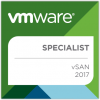Reading Time: 4 minutesVMware Cloud Foundation (VCF) is VMware’s unified SDDC platform for the hybrid cloud and it’s based on VMware’s compute, storage, and network virtualization technologies to deliver a native integrated software stack that can be used on-premises for private cloud deployment or run as a service from the public cloud with consistent and simple operations. The core components of VMware Cloud Foundation are VMware vSphere, vSAN (for the storage part), and NSX (for the network and security part). It’s more than a simple products bundle, because it gives a full validate stack with a fast provisioning, but also a better […]
Browsing Posts in VMware
Reading Time: 4 minutesNow that Network Virtualization and Software Defined Network are becoming mainstream, there is a new trend in networking: Software-Defined WAN (SD-WAN). What is SD-WAN? SD-WAN is best defined as traffic monitoring and management from physical devices to the application itself, capitalizing on flexibility and agility. This intelligent routing is abstracted into a virtual overlay, enabling a secured pooling of both private and public connections allowing for automation, centralized network control and real-time management across multiple links.

Reading Time: 10 minutesNow that both Microsoft and VMware have officially announced the new released of their virtualization products it’s possible to make some kind of comparison between Hyper-V available on Windows Server 2019 and vSphere 6.7 (like I’ve done some years ago with the Microsoft Hyper-V 2016 vs. VMware vSphere 6.5 article). Comparing two different product is not so easy, also if they are released closed one each other (at least in the same year). You need to found some homogenous aspects to make the comparison, at least at the technical level (but as written, it’s not so […]

Reading Time: 4 minutesVMware certification paths are quite clear with well defined technology paths (DCV, EUC, NV, Cloud) and different levels (VCP, VCAP, VCDX). All certifications require at least one proctored exam (some may require two different exams). The names of all exams and certifications will change using a “year” notation, but the concept remain the same. But there are also other type of exam, non proctored and just on-line version. One example are the Foundation exams.
Reading Time: 3 minutesQuick Boot is a vSphere feature that speeds up the upgrade process of an ESXi server. A regular reboot involves a full power cycle that requires firmware and device initialization. Quick Boot optimizes the reboot path to avoid this, saving considerable time from the upgrade process. Quick Boot of an ESXi host is a setting that allows VMWare Update Manager (VUM) to optimize the remediation time of hosts that undergo patch and upgrade operations. If the Quick Boot feature is enabled, Update Manager skips the hardware reboot (the BIOS or UEFI firmware reboot). As a result, the […]

Reading Time: 5 minutesOne of the most read post remain how to Purge old data from a vCenter Server DB, but was written on 17 January 2014 and related to vSphere 5.1 version with the vCenter Server based on Windows Server. Thinks are changed in those years, but problems could remain the same also with VCSA 6.x. You can have similar issue also with the VMware vCenter Server database, considering that it can continuous grow due to the statistics and also due to the events/tasks. In really small system a simple solution could be re-install a fresh version […]
Reading Time: 3 minutesLa nuova versione VMware vSphere 6.7U1 ha diverse migliore e nuove funzionalità già descritte nei post precedenti. Però c’è una funzionalità che in realtà è passata abbastanza inosservata. In realtà non è tanto una funzionalità ma una particolare compatibilità:finalmente VMware vSphere 6.7U1 supporta Active Directory 2016. In molti si dimenticano che le diverse componenti di vCenter Server, vCenter Single Sign-On (SSO) e VMware Platform Services Controller (PSC) hanno una particolare matrice di compatibilità con Active Directory, in particolare con i relativi livelli di funzionalità.










